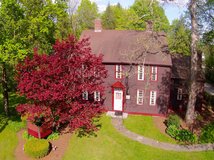AHSC co-Chair Nancy Gregg (front row ctr) Greg Stutsman (right) Denise LeDuc (left)
The
Amherst
Housing &
Sheltering
Committee heard plenty of news this morning, mostly bad.
Amherst
Housing
Authority Executive Director Denise LeDuc described the Section 8 program she oversees as a "no win situation" due to a cut in
Housing and
Urban
Development funds as a result of "sequestration."
A double barrel hit for affordable housing in Amherst as the number of vouchers are likely to be cut 11%, from 413 down to 368 ... meaning 45 families are out of luck.
Additionally the AHA will discuss at their next meeting reducing the amount of value each voucher represents. Currently, because of the high cost of housing in Amherst, the vouchers are valued at a "fair market rate" of 120% (compared to Springfield) but will be reduced to 105%.
Rising rent costs at both Rolling Green Apartments and Echo Village Apartments located next door also came up for discussion, led by assistant Town Manager Dave Ziomek standing in for Town Manager John Musante.
The town commissioned the
Massachusetts
Housing
Partnership to do an extensive inventory and structural analysis of
Echo Village as due diligence for possible purchase. Although Ziomek was quick to point out the "Town is not in business of buying housing to keep it affordable. We are trying to act as catalyst to make it happen."
The report cost $9,000 but
MHP absorbed half and the town paid the other half using Community Preservation Funds. Town Manager Musante has also commissioned MHP to do the same type of analysis for Rolling Green Apartments, a more expensive project as
Rolling Green (204 units) is far larger than Echo Village (24 units).
Rolling Green is higher on the priority list because the 204 units are all counted towards the town
Subsidized
Housing
Inventory (currently at 10.8%) and the loss of those units will drop us well below the magic 10% threshold (8.5%), allowing a developer to run roughshod over local zoning as long as their mega-project includes 25% affordable units.
The recent "Housing Production Plan" was accepted by the state last month so it buys the town a one year reprieve from a hostile Ch40B development, but the housing market needs to see 48 units of affordable housing added per year.
Olympia Oaks on East Pleasant Street is breaking ground any day now and will provide 42 units of affordable housing but the project has been in the works for many years, way prior to the Housing Production Plan, so the state could rule it does not count towards the 48 units.
According to Ziomek "the town is reaching out to
Department of
Housing and
Community
Development" to clarify the Olympia Oaks situation and to ascertain when the one year clock actually started ticking toward the end goal of 48 units.
In other bad news staff liaison Nate Malloy informed the committee that the Planning Board's "inclusionary zoning" article -- a tightening up of the currents regulations -- will not be ready for the fall town meeting.
The zoning bylaw would force developers (with projects greater than 10 units) in projects that are allowed "by right" to have a certain percentage be affordable, or a fine would be paid into an "affordable housing trust fund."
If for instance a developer builds 200 market rate units the minimum state standard requiring the town to stay above 10% threshold for affordability means that developer is creating a deficit of 20 units in the SHI index.
Inclusionary zoning would require them to cover the deficit either by including that minimum number of affordable units in the actual construction project or paying into a fund the purchase price of a three bedroom home.
At the August 21 Planning Board meeting "The Retreat," a 191 cottage style student housing project in northeast Amherst was used as an example, with a projection of up to 40 units of affordable housing being created
if the new bylaw was in effect.
But since that will take a two-thirds vote of Amherst Town Meeting to pass, a B-I-G "if" indeed.
Assistant Town Manager Dave Ziomek (left) Select Board member Alisa Brewer (right)
Meanwhile, UMass Prof gets
$3.2 million federal grant to prevent pregnant Hispanic women from, umm, getting fat.













































